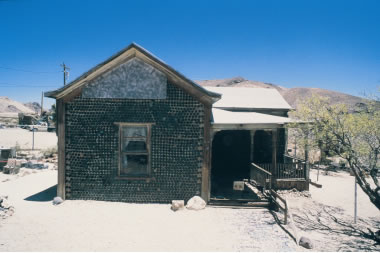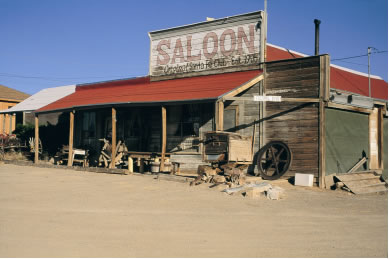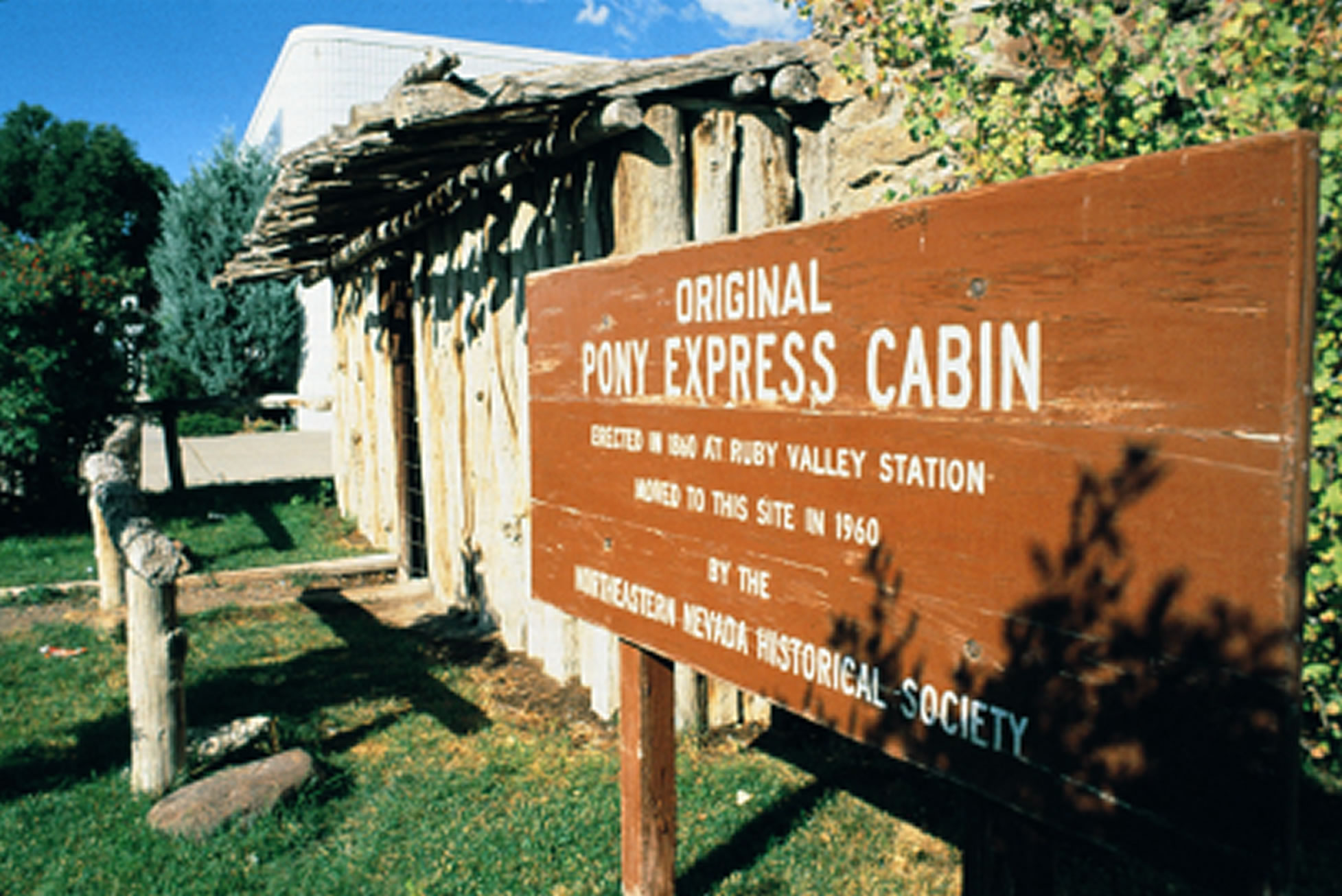|
Learn about the Ghost Towns of Nevada by reading Nevada
Ghost Towns by Charlie Spence, Travel Writer. It features a
mini, but thorough tour of the destination, plus all you'll need to
know to plan your trip including getting there, objective
information on places to stay and eat, and things to do. Enjoy!
Nevada Ghost Towns
by Charlie Spence,
Travel Writer and WTA Member
When you think
about a trip to Nevada probably your first thoughts are of Las Vegas or Reno and
the fabulous hotels, glittering shows, and crowded casinos. If so, you are
missing some of the most interesting places that can transplant you from those
modern Meccas to the roaring days of gold and silver rushes—the Nevada Ghost
Towns.
Gold and silver
played important roles in Nevada long before modern gambling. In 1849 gold was
discovered at a tent trading post near a community now called Dayton. A few
years later major silver and gold deposits were unearthed a little farther
north. The rush was on. Towns and mining centers sprang up throughout the
state. At least 575 towns, settlements and camps flourished for a half century.
Today, ghost towns and historic mining towns are found all around Nevada’s
scenic deserts, waiting for your exploration.
Some of these
historic mining towns are still inhabited with thriving businesses and
fascinating attractions. All, however, are much smaller than they were in their
boom days. The best way to thoroughly soak up the rich wonders of this unique
area is to rent a car, and set out for a nostalgic journey.
The route to
your destination can be just as interesting as the destination itself. Ten
scenic highways lead you through landscapes, tribal lakes, and historic or
modern communities. Unless you have unlimited time to devote to this pleasure,
it’s best to select one or two routes on each journey to the Silver State so you
can thoroughly enjoy what these places have to offer.
One trip to the
past starts in Las Vegas. Go north on route 95 and your first stop might be at
Amargosa Valley where big sand dunes cover about three square miles. The dunes
are the remains of a prehistoric lake that covered this section. Height of the
dunes reaches 500 feet with some sharp drop offs.

Photo courtesy Nevada Commission on Tourism
When building materials were scarce, this house near Rhyolite was constructed of
bottles.
It stands today waiting for you to examine it.
Continuing
north on 95 you will come to Beatty with several motel/casinos. Four miles west
is Rhyolite, your first sight of a true Nevada ghost town. In 1904 the “Bulldog”
strike brought some 6,000 residents to this town. They brought a modern
telephone system, electric street lights, hotels with private baths, water
companies, dozens of saloons, a symphony orchestra, and newspapers. Late in 1907
a national panic caused the mines to close. Residents deserted for Los Angeles
and a new community in the southern part of Nevada—Las Vegas. Persons continued
to leave and by 1920 the town was deserted and many of the buildings were
dismantled for the building materials. The old train depot and the concrete
ruins of an old bank, important buildings in the bustling days of mining, still
stand. Also, take time to look at the house built of 20,000 bottles in 1906 when
building materials were scarce. Rhyolite, named for a type of volcanic rock
found in the area, is one of the most photographed locations in the state.

Photo courtesy Nevada Commission on Tourism
One of the old saloons that dotted the
town of Goldfield in the roaring days still can be visited today.
Look through the windows and you can almost hear the honky-tonk piano and the
ruckus of the unwinding miners.
Continue north
on route 95, skirting Nellis, the secret military base, and conjure in your mind
the types of experiments that might be going on in there as you pass by.
Goldfield and Tonopah welcome you to the mining days. Rich gold deposits were
discovered in 1902 and within a few years Goldfield had a population of more
than 25,000, making it the largest city in the state. There were dozens of
saloons, banks, and the most luxurious hotel between Kansas City and San
Francisco. Many of the historic buildings remain, some still in use by the much
smaller community. The courthouse and old Goldfield Hotel (now closed) are
reminders of those golden days.
At this point
you are about half way between Las Vegas and Reno. Here you can retrace the
route and visit those spots where you said “I wish I had spent more time,” or
take a return route to Las Vegas on the eastern side of Nellis.
If you feel
adventurous, take a different tour—the route of the old Pony Express. Although
this communication service lasted only about a year and a half, its exploits are
legend. Daring young men, with leather mail pouches strapped to their horses,
crossed the area carrying the mail the 1,800 miles between California and
Missouri in 10 days. Indians, desperadoes, weather elements, and fatigue were
only some of the dangers faced when this was the only means of communication
between the nation in the east and the developing, untamed west.

Photo courtesy Nevada Commission on Tourism
Stop by one of the original Pony Express cabins you will find
along “The Loneliest Road in America".
Today you may
follow that same route across Nevada along highway 50, called by a magazine
“the
Loneliest Road in America.” Begin this journey through the old mining towns from
a base at Reno. The distance across Nevada’s section of the Pony Express route
is 346 miles so if your time is limited plan your stops to catch only a few of
the interesting places. Accommodations are available at most of the communities
along the way.
One of your
first stops might be Fort Churchill. Now an historic state park, Fort Churchill
was constructed in 1860 to protect western Nevada settlers and travelers on the
trail west. The fort ruins have been preserved. The park offers camping,
horseback riding trails, and is a favorite spot for users of off-road vehicles
to travel the 16-mile dirt track along the banks of the Carson River.
Just 15 miles
east of Fallon, visit Grimes Point and Hidden Cave for a look at the region’s
prehistoric past. At Grimes Point wander through rocky areas covered with
ancient Indian Rock carvings. Take time to look at the artifacts uncovered in
the area by archaeologists.
Your next stop
is Austin, which remains one of the best unreconstructed mining camps. Along the
way you can see the Pony Express stops, marked at Cold Springs, Middle Gates,
and Sand Springs.
Travel about
two hours from Austin and you are at Berlin and Ichthyosaur State Park
(pronounced ick-thee-o-sore). Ichthyosaurs were the marine reptiles that swan in
the ocean that covered Nevada some 225 million years ago. You can take a look at
some of the remains of these ancient reptiles at the park’s fossil house. In
1895 silver was discovered here and the town of Berlin was formed. A large mill
was erected to process the ore and this flourished until the mines closed in
1918.
About 250
persons lived in
Berlin, including miners, woodcutters, a forest ranger, a
doctor and nurse, and a prostitute. There were a store and post office, stamp
mill, assay office, and stage station as well as houses. Most of these buildings
still remain as a ghost town for you and future generations to see. As you walk
the deserted streets of Berlin, learn from the descriptive signs, and peer into
the windows of the abandoned structures while you let your imagination run wild
with the way this untamed western town was a century ago.
More than three
miles of tunnels reveal where the prospectors pulled an estimated $895,000 from
the earth when gold was $20 per ounce. Take a tour of
Diana Mine and see the
tools these miners used: ore cart, timbering, and other mining tools. Venture
into the side tunnels. For times when tours are available and to make
reservations, check the web site
www.parks.nv.gov.
You can
continue along the old trail through
Eureka and Ely, if your schedule permits,
or retrace your route. Whatever your choice, the routes always offer something
new. Ghost towns and mining towns are found all over the state. In Nevada, the
odds are with you that you will find a winning selection of interesting places
to visit.
Nevada Details
How To Get There:
If
you plan to start your Ghost Town tour in Las Vegas, any number of
airlines serve the area. McCarran International Airport is the main
airline terminal, about five miles south of the city. If you want to
start on the Pony Express tour, try Reno for your landing point.
Reno/Tahoe International is the commercial service field. It is
three miles from the city.
Where To Stay:
All
of Nevada offers a wide variety of accommodations ranging from
inexpensive motels—$45 to $100 a night—to plush hotels. There are
many Bed and Breakfast spots. You can even rent a houseboat. Rates
of all vary with the location, the season, the quality of
facilities.
WTA’s Travel Access Discount Program serves up deeper discounts on hotels, car rentals, flights, and activities all over the world. Most of our travel deals are not available to the public, which means rates are much lower than what the average consumer can find online. Click here to start accessing for free today.
Notice: This information is current as of August
2005. It is recommended that you contact the numbers, and/or visit the web sites
above to determine any changes to the information.
|